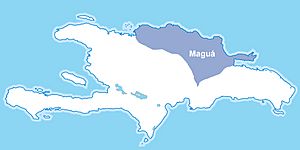Ciguayos facts for kids
The Ciguayos were a group of indigenous people who lived in the Samaná Peninsula and nearby areas of what is now the Dominican Republic. They were likely living there before the Taíno people, who were farmers and lived in most parts of the island. The Ciguayo language was spoken along the northeastern coast, from Nagua down to the Yuna River, and all over the Samana Peninsula.
When the Spanish first arrived, they saw the Ciguayos as a threat. Early Spanish writers described them as having long hair and using bows with poisoned arrows. Their skill with bows and arrows is thought to be connected to the Kalinago or Island Caribs. Today, the Ciguayos are remembered in local stories, and their history has been important in the Dominican movement to recognize indigenous heritage since the 1800s.
Who Were the Ciguayos?
The Ciguayos were seen as a distinct group of people. They lived on the Samaná Peninsula and parts of the northern coast near Nagua in the Dominican Republic. Most people at the time agreed that their language and customs were different from the classical Taíno people, who lived in the eastern part of the island of Hispaniola.
The Ciguayos looked different from the Taínos. They were taller and painted their bodies with black dye. They also let their hair grow very long and decorated it with feathers, according to Bartolomé de las Casas, an early Spanish historian. The Ciguayos also had a more serious look than the Taínos. Their bows were larger, and their arrows had poison on the tips. They spoke a different language from most people on the island.
Around the late 1400s, the Ciguayos lived in the mountains of Macorís de Arriba, which are now part of the Cordillera Septentrional mountain range. This area was then called Ciguay. Their leader was Mayobanex. Some historians also mention that around 1500, this area was the chiefdom of a leader named Guacangarí.
Historians like Eustaquio Fernandez de Navarrete described them as "brave and warlike people." Another historian, Pedro Martir, wrote that they were fierce warriors.
Their Unique Language
Fray Ramón Pané, who is sometimes called the first anthropologist of the Caribbean, noted that the Ciguayos' language was different from other languages spoken on Hispaniola. Bartolomé de las Casas studied the Ciguayos and was one of the few who read Pané’s original writings. Most of what we know about the Ciguayos comes from Las Casas.
Only one Ciguayo word was ever written down by Las Casas: tuob, which meant "gold." Based on this single word, some researchers like Granberry & Vescelius (2004) believe that the Ciguayo language might be related to the Tol language spoken in Honduras. This suggests that the Ciguayos might have originally come from Mesoamerica (a region in Central America). These researchers also think that the original name for Hispaniola, Kiskeya, might have come from the Ciguayo language and could have meant "a very mountainous, heavily forested terrain."
See also
 In Spanish: Ciguayos para niños
In Spanish: Ciguayos para niños



